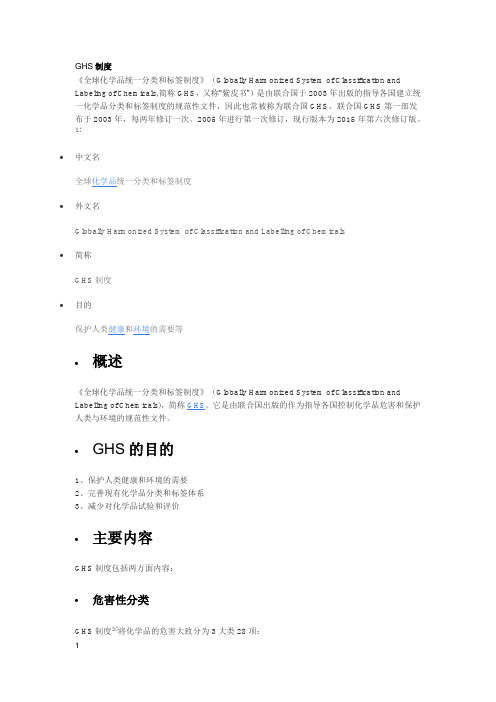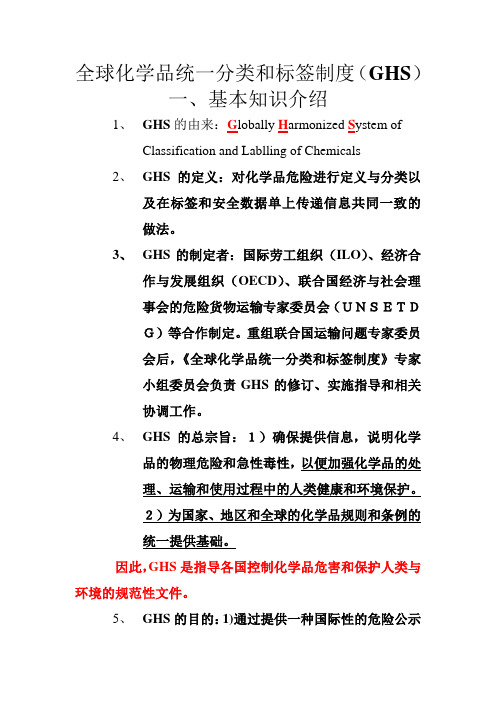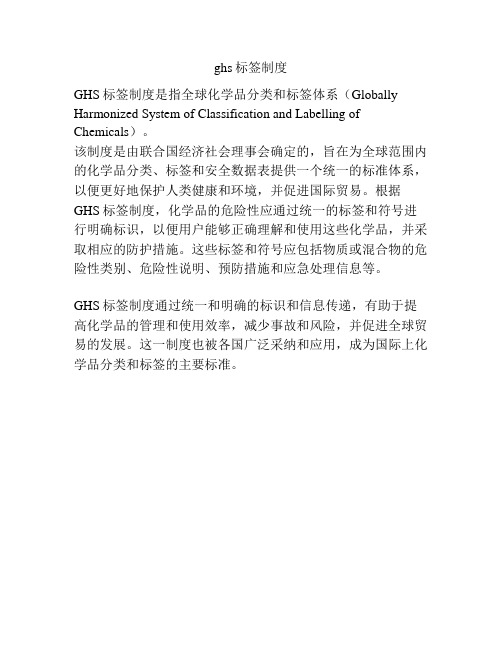GHS《全球化学品统一分类和标签制度》英文版 Introduction:Historical background
GHS《全球化学品统一分类和标签制度》英文版Health and environmental hazards:classification criteria f

Yes Danger
Cont’d
© United Nations Economic Commission for Europe. All rights reserved
UNITED NATIONS
Acute toxicity: decision logic (3)
No According to the criteria, does the substance have an: · Oral LD50 >2000 but < 5000 mg/kg bodyweight, or · Dermal LD50 >2000 but < 5000 mg/kg bodyweight, or · Inhalation (gas, vapour and/or dust/mist) LC50 in the equivalent range of the oral and dermal LD50 (i.e., 2000-5000 mg/kg bodyweight) No · Is there reliable information available indicating significant toxicity effects in humans?; or · Was any mortality observed when tested up to Category 4 values by the oral, inhalation or dermal routes?; or · Is there expert judgement that confirms significant clinical signs of toxicity, when tested up to Category 4 values, except for diarrhea, piloerection or an ungroomed appearance?; or · Is there expert judgement that confirms reliable information indicating the potential for significant acute effects from other animals? No
全球化学品统一分类和标签制度(GHS)简介.doc

全球化学品统一分类和标签制度(GHS)简介《全球化学品统一分类和标签制度》(Globally Harmonized System of Classification and Lablling of Chemicals,简称GHS,又称紫皮书)是由联合国出版的指导各国控制化学品危害和保护人类健康与环境的规范性文件。
2002年联合国可持续发展世界首脑会议鼓励各国2008年前执行GHS。
APEC会议各成员国承诺自2006年起执行GHS。
2011年联合国经济和社会理事会25号决议要求GHS专家分委员会秘书处邀请未实施GHS的政府尽快通过本国立法程序实施GHS。
一、建立GHS目的目前世界上大约拥有数百万种化学物质,常用的约为7万种,且每年大约上千种新化学物质问世。
很多化学品对人体健康以及环境造成一定的危害,如某些化学物质具有腐蚀性,致畸性,致癌性等。
由于部分化学从业人员对化学品缺乏安全使用操作意识,在化学品生产,储存,操作,运输,废弃处置中,难免对损害自身健康,或给环境带来负面影响。
多年来,联合国有关机构以及美国,日本,欧洲各工业发达国际都通过化学品立法对化学品的危险性分类,包装和标签作出明确规定。
由于各国对化学品危险性定义的差异,可能造成某种化学品在一国被认为是易燃品,而在另一国被认为是非易燃品,从而导致该化学品在一国作为危险化学品管理而另一国却不认为是危险化学品。
在国际贸易中,遵守各国法规的不同危险性分类和标签要求,既增加贸易成本,又耗费时间。
为了健全危险化学品的安全管理,保护人类健康和生态环境,同时为尚未建立化学品分类制度的发展中国家提供安全管理化学品的框架,有必要统一各国化学品统一分类和标签制度,消除各国分类标准,方法学和术语学上存在的差异,建立全球化学品统一分类和标签制度。
二、GHS建立时间表1992年:联合国环境和发展大会通过了《21世纪议程》,建议:如果可行,到2000年应当提供全球化学品统一分类和配套的标签制度,包括化学品安全数据说明书和易理解的图形符号。
化学品分类与标记全球协调制度GHS

GHS是用于定义和分类化学品而制定的一种常规、连贯的方法,并
通过标签和安全数据表向其他环节传递信息的制度。 目标人群包括工人、消费者、运输工人、紧急情况应对人员等。 为国家建立全面的化学品安全制度提供结构框架。
确认危险物质,并针对各物质制定法规超出了任何国家、组织能
GHS标签应包括适当的预防性信息; GHS文件中包含了可用的预防性信息表述示例; 本要素的目的是在将来使预防性信息也得到标准化。
物化性危害 健康及环境危害 危害性 爆炸物 易燃气体 易燃气胶 氧化性气体 高压气体 易燃液体 易燃固体 自反应物质 发火液体 发火固体 自热物质 禁水性物质 氧化性液体 氧化性固体 有机过氧化物 金属腐蚀性 急毒性 皮肤腐蚀/刺激 眼睛严重损害/刺激 呼吸道或皮肤过敏 致突变性 致癌性 生殖毒性 标的器官毒性-单一暴露 标的器官毒性-重复暴露 水中环境危害
图式
现行 规定 4.2 8 -
1 2.1*2.1 5.1 4.2 4.2 4.2 4.3 6.1*8 8 - - -
2.2 3* 4.1 5.1 5.1 5.2 - - -
SDS应能提供化学物质或其混合物的综合信 息; 主要用途:工作场所; 受雇人员、工人可将SDS作为获取物质危险 信息或安全性防护措施的源泉。
4. 1989 年,国际劳工组织接受了一项有关于工作场所中危害性 化学品使用上分类和标记的决议,在1990年,发表了一项关于 工作场所中化学品使用的安全协议和建议案。 5. 为降低对劳工与消费者身体危害及环境污染,并减少跨国贸 易障碍,联合国环境发展会议 ( UNCED ) 与国际化学品安全论 坛 ( IFCS ) 于1992 年通过决议,建议各国应展开国际间化学品 分类与标记调和工作。 UNCED 与 IFCS 于1992 年通过决议,建议各国应展开国际间化 学品分类与标记协调工作,以减少化学品对人体与环境造成的 危险、及减少化学品跨国贸易必须符合各国不同标记规定所衍 生的成本。故由 ILO、OECD 与 UNCETDG 共同研拟化学品分类 与标记的GHS ,其分工为: (1) OECD :负责制订化学品对人体 健康与环境的危险分类标准; (2) UNCETDG :负责制订化学品 物性安全标准; (3) ILO :根据前两个单位发展出标准,负责发 展出相关的标记与分类方式。
ghs《全球化学品统一分类和标签...

© United Nations Economic Commission for Europe. All rights reserved
UNITED NATIONS
International recognition (4)
In 1992, the UN Conference on the Environment and Development (UNCED) established 6 programme areas to strengthen national and international efforts related to the environmentally sound management of chemicals, as follows:
UNITED NATIONS
International recognition (3)
Adoption of these instruments requires a country to have a system for hazard classification and labelling/marking in accordance with national or international standards. Moreover, due to:
© United Nations Economic Commission for Europe. All rights reserved
Байду номын сангаас
UNITED NATIONS
International recognition (2)
In 1980-1990, the International Labor Organization (ILO) adopted a Convention (Convention No. 170) and a Recommendation (Recommendation No.177) concerning the harmonization of systems of classification and labelling for the use of hazardous chemicals at work.
GHS制度《全球化学品统一分类和标签制度》

GHS制度《全球化学品统一分类和标签制度》(Globally Harmonized System of Classification andLabeling of Chemicals,简称GHS,又称“紫皮书”)是由联合国于2003年出版的指导各国建立统一化学品分类和标签制度的规范性文件,因此也常被称为联合国GHS。
联合国GHS第一部发布于2003年,每两年修订一次。
2005年进行第一次修订,现行版本为2015年第六次修订版。
[1]•中文名全球化学品统一分类和标签制度•外文名Globally Harmonized System of Classification and Labelling of Chemicals•简称GHS制度•目的保护人类健康和环境的需要等•概述《全球化学品统一分类和标签制度》(Globally Harmonized System of Classification andLabelling of Chemicals),简称GHS。
它是由联合国出版的作为指导各国控制化学品危害和保护人类与环境的规范性文件。
•GHS的目的1、保护人类健康和环境的需要2、完善现有化学品分类和标签体系3、减少对化学品试验和评价•主要内容GHS制度包括两方面内容:•危害性分类GHS制度[2]将化学品的危害大致分为3大类28项:1) 物理危害(如,易燃液体、氧化性固体等16项)。
2) 健康危害(如,急性毒性、皮肤腐蚀/刺激等10项)。
3) 环境危害(如,水、臭氧层等2项)。
•危害信息公示GHS制度采用两种方式公示化学品的危害信息:1) 标签。
2) 安全数据单(safety data sheet,简称SDS)。
注:在我国的标准中常称为“物质安全数据表”(MSDS)。
在GHS制度中一个完整的标签至少含有5个部分:信号词,危险说明,象形图,防范说明等。
化学品危害信息统一公示之安全数据单(SDS)包括下面16方面的内容:1.标识,2.危害标识,3.成分构成/成分信息,4.急救措施,5.消防措施,6.意外泄漏措施,[3]7.搬运和存储,8.接触控制/人身保护,9.物理和化学性质,10.稳定性和反应性,11.毒理学信息,12.生态学信息,13.处置考虑,14.运输信息,15.管理信息,16.其它信息[4]•覆盖范围GHS制度涵盖了所有的化学品;GHS针对的目标对象包括消费者、工人、运输工人以及应急人员;化学品在人类有意摄入时的标签不在GHS的覆盖范围内,如药品、食品添加剂、化妆品和食品中的杀虫剂残留。
全球化学品统一分类和标签制度(GHS)简介

编号:SY-AQ-01644( 安全管理)单位:_____________________审批:_____________________日期:_____________________WORD文档/ A4打印/ 可编辑全球化学品统一分类和标签制度(GHS)简介Brief introduction of GHS全球化学品统一分类和标签制度(GHS)简介导语:进行安全管理的目的是预防、消灭事故,防止或消除事故伤害,保护劳动者的安全与健康。
在安全管理的四项主要内容中,虽然都是为了达到安全管理的目的,但是对生产因素状态的控制,与安全管理目的关系更直接,显得更为突出。
《全球化学品统一分类和标签制度》(GloballyHarmonizedSystemofClassificationandLabllingofCh emicals,简称GHS,又称“紫皮书”)是由联合国出版的指导各国控制化学品危害和保护人类健康与环境的规范性文件。
2002年联合国可持续发展世界首脑会议鼓励各国2008年前执行GHS。
APEC 会议各成员国承诺自2006年起执行GHS。
2011年联合国经济和社会理事会25号决议要求GHS专家分委员会秘书处邀请未实施GHS 的政府尽快通过本国立法程序实施GHS。
一、建立GHS目的目前世界上大约拥有数百万种化学物质,常用的约为7万种,且每年大约上千种新化学物质问世。
很多化学品对人体健康以及环境造成一定的危害,如某些化学物质具有腐蚀性,致畸性,致癌性等。
由于部分化学从业人员对化学品缺乏安全使用操作意识,在化学品生产,储存,操作,运输,废弃处置中,难免对损害自身健康,或给环境带来负面影响。
多年来,联合国有关机构以及美国,日本,欧洲各工业发达国际都通过化学品立法对化学品的危险性分类,包装和标签作出明确规定。
由于各国对化学品危险性定义的差异,可能造成某种化学品在一国被认为是易燃品,而在另一国被认为是非易燃品,从而导致该化学品在一国作为危险化学品管理而另一国却不认为是危险化学品。
全球化学品统一分类和标签制度GHS简介

全球化学品统一分类和标签制度(G H S)简介《全球化学品统一分类和标签制度》(GloballyHarmonizedSystemofClassificationandLabllingofChem icals,简称GHS,又称“紫皮书”)是由联合国出版的指导各国控制化学品危害和保护人类健康与环境的规范性文件。
2002年联合国可持续发展世界首脑会议鼓励各国2008年前执行GHS。
APEC会议各成员国承诺自2006年起执行GHS。
2011年联合国经济和社会理事会25号决议要求GHS专家分委员会秘书处邀请未实施GHS的政府尽快通过本国立法程序实施GHS。
一、建立GHS目的目前世界上大约拥有数百万种化学物质,常用的约为7万种,且每年大约上千种新化学物质问世。
很多化学品对人体健康以及环境造成一定的危害,如某些化学物质具有腐蚀性,致畸性,致癌性等。
由于部分化学从业人员对化学品缺乏安全使用操作意识,在化学品生产,储存,操作,运输,废弃处置中,难免对损害自身健康,或给环境带来负面影响。
多年来,联合国有关机构以及美国,日本,欧洲各工业发达国际都通过化学品立法对化学品的危险性分类,包装和标签作出明确规定。
由于各国对化学品危险性定义的差异,可能造成某种化学品在一国被认为是易燃品,而在另一国被认为是非易燃品,从而导致该化学品在一国作为危险化学品管理而另一国却不认为是危险化学品。
在国际贸易中,遵守各国法规的不同危险性分类和标签要求,既增加贸易成本,又耗费时间。
为了健全危险化学品的安全管理,保护人类健康和生态环境,同时为尚未建立化学品分类制度的发展中国家提供安全管理化学品的框架,有必要统一各国化学品统一分类和标签制度,消除各国分类标准,方法学和术语学上存在的差异,建立全球化学品统一分类和标签制度。
二、GHS建立时间表1992年:联合国环境和发展大会通过了《21世纪议程》,建议:“如果可行,到2000年应当提供全球化学品统一分类和配套的标签制度,包括化学品安全数据说明书和易理解的图形符号”。
全球化学品统一分类和标签制度简介(最新版)

( 安全管理 )单位:_________________________姓名:_________________________日期:_________________________精品文档 / Word文档 / 文字可改全球化学品统一分类和标签制度简介(最新版)Safety management is an important part of production management. Safety and production are inthe implementation process全球化学品统一分类和标签制度简介(最新版)《全球化学品统一分类和标签制度》(GloballyHarmonizedSystemofClassificationandLabllingofChe micals,简称GHS,又称“紫皮书”)是由联合国出版的指导各国控制化学品危害和保护人类健康与环境的规范性文件。
2002年联合国可持续发展世界首脑会议鼓励各国2008年前执行GHS。
APEC会议各成员国承诺自2006年起执行GHS。
2011年联合国经济和社会理事会25号决议要求GHS专家分委员会秘书处邀请未实施GHS的政府尽快通过本国立法程序实施GHS。
一、建立GHS目的目前世界上大约拥有数百万种化学物质,常用的约为7万种,且每年大约上千种新化学物质问世。
很多化学品对人体健康以及环境造成一定的危害,如某些化学物质具有腐蚀性,致畸性,致癌性等。
由于部分化学从业人员对化学品缺乏安全使用操作意识,在化学品生产,储存,操作,运输,废弃处置中,难免对损害自身健康,或给环境带来负面影响。
多年来,联合国有关机构以及美国,日本,欧洲各工业发达国际都通过化学品立法对化学品的危险性分类,包装和标签作出明确规定。
由于各国对化学品危险性定义的差异,可能造成某种化学品在一国被认为是易燃品,而在另一国被认为是非易燃品,从而导致该化学品在一国作为危险化学品管理而另一国却不认为是危险化学品。
全球化学品统一分类和标签制度文稿

全球化学品统一分类和标签制度(GHS)一、基本知识介绍1、GHS的由来:G lobally H armonized S ystem ofClassification and Lablling of Chemicals2、GHS的定义:对化学品危险进行定义与分类以及在标签和安全数据单上传递信息共同一致的做法。
3、GHS的制定者:国际劳工组织(ILO)、经济合作与发展组织(OECD)、联合国经济与社会理事会的危险货物运输专家委员会(UNSETDG)等合作制定。
重组联合国运输问题专家委员会后,《全球化学品统一分类和标签制度》专家小组委员会负责GHS的修订、实施指导和相关协调工作。
4、GHS的总宗旨:1)确保提供信息,说明化学品的物理危险和急性毒性,以便加强化学品的处理、运输和使用过程中的人类健康和环境保护。
2)为国家、地区和全球的化学品规则和条例的统一提供基础。
因此,GHS是指导各国控制化学品危害和保护人类与环境的规范性文件。
5、GHS的目的:1)通过提供一种国际性的危险公示制度,加大对人类健康和环境的保护;2)为尚未制定制度的那些国家提供一个公认的框架;3)减少实验和评价化学品的必要性;4)促进其危险度已在国际上得到恰当评估和认定的化学品的国际贸易。
6、GHS的实施时间:1)1992年里约日内卢联合国环境与发展会议《21世纪议程》提出任务;2)2002年12月联合国危险货物运输和全球化学品统一分类和标签制度专家委员会通过GHS工作报告(紫皮书)并鼓励2008年全面实施;3)中国2002年9月2日,朱镕基总理在“联合国可持续发展世界首脑会议”上投票支持。
7、GHS的产生背景:1)1952年联合国国际劳工组织的化学工作委员会研究危险品的分类和标记。
2)1953年,联合国经济与社会理事会(ECSOC)的欧洲经济理事会下设的危险品运输专家委员会(CETDG)研究第一个国际性的危险品运输分类和标记体系。
即1956年颁布了《联合国关于危险货物运输的建议书》(UNRTDG)。
化学品全球统一分类与标签制度(GHS)介绍

第十一页,共71页。
1111
WHY: 為什麼要推行GHS?
推行GHS的好處有:
藉由提供一個國際上易理解之危害通識系統,以提高 人類健康及環境之保護。
對尚未有相關系統之國家,提供認可之工作架構。 降低化學品測試及評估之需求。 對已有適當評估及確認危害之化學品,促進其國際貿
易。 建立實驗室化學品管理之基礎,增進工作人員及師生
行政院勞工委員會八十二年十二月二十日台八十二 勞安三字第七六二八九號公告
依勞工安全衛生法第四條第一項第十五款及同條第二 項之規定,指定適用勞工安全衛生法之事業、適用部 分工作場所之事業如下:
一、職業訓練事業、顧問服務業、學術研究及服務業、教育訓練 服務業之大專院校等之實驗、試驗室、實習工場或試驗工場。
標示(Labelling) 物 質 安 全 資 料 表 ( Material Safety Data Sheet,
MSDS/SDS)
分類級別(Classification Categories)
4
第四页,共71页。
WHAT: 什麼是GHS? (續)
應用 GHS 之參數(parameter)
GHS 國家執行策略
GHS 危害分類與測試
8
第八页,共71页。
WHO: 誰適用GHS?
消費者(Consumers) 工作場所勞工(Workers) 運輸工人(Transport Workers) 緊急應變者(Emergency Responders)
學校、教育單位?
9
第九页,共71页。
WHO: 誰適用GHS? (續)
2.2組 非易燃、非毒性氣體
2.3組 毒性氣體
第四類 易燃固體、自燃物質、禁水性物質
6.1組 毒性物質
ghs标签制度

ghs标签制度
GHS标签制度是指全球化学品分类和标签体系(Globally Harmonized System of Classification and Labelling of Chemicals)。
该制度是由联合国经济社会理事会确定的,旨在为全球范围内的化学品分类、标签和安全数据表提供一个统一的标准体系,以便更好地保护人类健康和环境,并促进国际贸易。
根据GHS标签制度,化学品的危险性应通过统一的标签和符号进行明确标识,以便用户能够正确理解和使用这些化学品,并采取相应的防护措施。
这些标签和符号应包括物质或混合物的危险性类别、危险性说明、预防措施和应急处理信息等。
GHS标签制度通过统一和明确的标识和信息传递,有助于提高化学品的管理和使用效率,减少事故和风险,并促进全球贸易的发展。
这一制度也被各国广泛采纳和应用,成为国际上化学品分类和标签的主要标准。
- 1、下载文档前请自行甄别文档内容的完整性,平台不提供额外的编辑、内容补充、找答案等附加服务。
- 2、"仅部分预览"的文档,不可在线预览部分如存在完整性等问题,可反馈申请退款(可完整预览的文档不适用该条件!)。
- 3、如文档侵犯您的权益,请联系客服反馈,我们会尽快为您处理(人工客服工作时间:9:00-18:30)。
© United Nations Economic Commission for Europe. All rights reserved
UNITED NATIONS
International mandate
Agenda 21, Chapter 19, Programme Area B, paras. 26 and 27:
“26.
© United Nations Economic Commission for Europe. All rights reserved
UNITED NATIONS
Process of harmonization (1)
The development of a harmonized system of classification and labelling of chemicals started with the examination of existing systems/recommendations/legislation: • in countries; • in international/intergovernmental organizations (ex.: OECD Chemicals Programme; ILO Chemical Safety Tools; UN Recommendations for transport of dangerous goods; FAO Recommendation on Pesticides; European Union directives for classification and labelling of substances and preparations).
© United Nations Economic Commission for Europe. All rights reserved
UNITED NATIONS
International recognition (4)
In 1992, the UN Conference on the Environment and Development (UNCED) established 6 programme areas to strengthen national and international efforts related to the environmentally sound management of chemicals, as follows: 1. Expanding and accelerating international assessment of chemical risks; 2. Harmonization of classification and labelling of chemicals. 3. Information exchange on toxic chemicals and chemical risks; 4. Establishment of risk reduction programmes; 5. Strengthening of national capabilities and capacities for management of chemicals; 6. Prevention of illegal international traffic in toxic and dangerous products. (Agenda 21, Chapter 19: Programme Areas)
© United Nations Economic Commission for Europe. All rights reserved
UNITED NATIONS
Process of harmonization (2)
Analysis of existing systems showed that: • Scope of countries/organizations was very broad. • Extensive expertise was needed; Therefore, need to decide: • what systems would be considered “major” (and used as the primary basis for the harmonization process); and • how could the work be divided to get the best expertise for different aspects?
Convention concerning safety in the use of chemicals at work (C.170) Recommendation concerning safety in the use of chemicals at work (R.177)
© United Nations Economic Commission for Europe. All rights rese Economic Commission for Europe. All rights reserved
© United Nations Economic Commission for Europe. All rights reserved
UNITED NATIONS
International recognition (2)
In 1980-1990, the International Labor Organization (ILO) adopted a Convention (Convention No. 170) and a Recommendation (Recommendation No.177) concerning the harmonization of systems of classification and labelling for the use of hazardous chemicals at work.
© United Nations Economic Commission for Europe. All rights reserved
UNITED NATIONS
Process of harmonization (3)
“Major” systems identified: • USA requirements for workplace, consumers and pesticides; • Canada requirements for the workplace; consumers and pesticides; • European Union directives for classification an labelling of substances and preparations; • United Nations Recommendations on the Transport of Dangerous Goods.
The Globally Harmonized System of Classification and Labelling of Chemicals (GHS)
Historical background
(The contents of this presentation have been updated according to the second revised edition of the GHS, published in 2007)
© United Nations Economic Commission for Europe. All rights reserved
UNITED NATIONS
International recognition (1)
Chemical products have the potential for adverse effects to people or the environment. As a result, a number of countries or organizations have developed laws or regulations that require information to be prepared and transmitted to those using chemicals, through labels or Safety Data Sheets (SDS). While these existing laws or regulations are similar in many respects, their differences are significant enough to result in different labels or SDS for the same product in different countries.
